Introduction
Previous work by the Pew Internet Project suggests that the communicative functions of the internet and cell phones are the main reason why teens use these technologies.17,18 Since many of these technologies are text-based, they constitute another potential space for writing under a broadly constructed definition of the term. Yet despite the ubiquitous use of these tools, our research suggests that teens see an important distinction between the “writing” that they do for school and for personal reasons, and the “communication” they engage in electronically using instant messaging, text messaging, email and social networking sites.
However these tools are defined, many educators and observers have expressed concern that the abbreviated language styles of text messaging, email and wall posts are filtering inappropriately into formal school writing. Young adults generally do not believe that technology negatively influences the quality of their writing, but they do acknowledge that the informal styles of writing that mark the use of these text-based technologies for many teens do occasionally bleed into their school work.
Communication with friends and family is frequently conducted through the prism of technology, particularly among girls and older teens.
Despite the range of online communication tools available to them, teens continue to rely primarily on telephone or face-to-face interactions to communicate daily with their friends. More than one-third of teens say they talk with their friends in person outside of school (39%), talk on a cell phone or landline phone (35%), or send text messages (36%) on a daily basis.
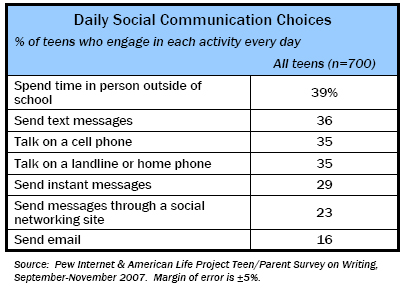
While verbal modes of communication such as talking on the phone or meeting face-to-face dominate the daily lives of teens, a great deal of social interaction occurs in a text-based setting. The most popular of these interactions is text messaging—36% of teens text message their friends daily. As one of our focus group participants noted, text messaging can be both time-consuming and integrated in daily tasks.
I put in 20 hours [per week] plus [texting]. I can’t even count because I mean it’s not like you’re spending a continuous hour writing/texting. It’s just like text, text, text while you’re doing other stuff.
– 10/12th Grade Girl, Southwestern City.
Of course, computer-based communication is popular as well. Nearly three in ten teens (29%) send instant messages to their friends daily, and close to one quarter (23%) send messages through social network sites. As in previous Pew Internet Project research,19 email remains the least popular choice for daily communication: just 16% of teens send email to their friends on a daily basis.
Teens choose different methods for communicating with friends based on personal preference, the availability of friends or potential romantic partners in a particular media space, and the costs and logistics involved:
I actually wrote a long message to my friend yesterday . . . . like 5 paragraphs . . . [sent] . . . just to him because sometimes I don’t like saying stuff to people in person. I just feel more comfortable when I say it on the computer. I can get more feelings out so I just went on and on and on. I was explaining a situation to my friend and that was probably the longest thing I’ve ever written on My Space.
– 9/11th Grade Girl, Southwestern City.
I instant message . . . I don’t text because texting costs, so I IM.
– 10/12th Grade Girl, Southwestern City.
Well I don’t really do text messaging on my own phone. But sometimes I’ll borrow a friend’s phone and like a lot of it is just kind of screwing around with your phone. You’ll leave like hi, what are you doing?
– 9/11th Grade Girl, Southwestern City.
Some people they text – somebody could be sitting right here and I could be texting somebody and they’d be standing right there. I mean what is the point?
– 11/12th Grade Boy, Northeastern City.
I used my cell phone, maybe an hour a day. Secondary would be instant messaging on the computer . . . . It is just easier to communicate using instant messenger instead of using the phone.
– 9/10th Grade Boy, Pacific Northwest City.
If it wasn’t for girls, we wouldn’t be talking on the phone or using IM or anything else like that. Or I guess not using it as much.
– 11/12th Grade Boy, Northeastern City.
Girls and older teens are more likely than boys and younger teens to engage in a variety of daily communications activities. Girls are significantly more likely than boys to socialize or engage with friends daily via a home or landline telephone, cell phone, text messaging, instant messaging, email, and through private messages within a social networking site. Girls and boys are equally likely to meet with friends in person outside of school on a daily basis.
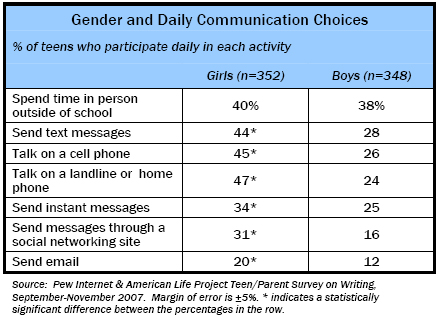
While older and younger teens are equally likely to socialize daily with friends in person or on a landline phone, older teens are more likely to communicate daily with friends via text messaging (50% for older teens vs. 22% for younger teens), instant messaging (34% vs. 24%), cell phone (47% vs. 24%) and messages on social network sites (34% vs. 13%). This is at least partly because older teens are more likely to own the technologies (such as cell phones or computers) that make these communications possible.
Socio-economic status is correlated with the daily communication choices made by teens, although not strongly so. Teens living in households with an annual income under $50,000 per year and those with annual incomes of $50,000 or more are equally likely to participate daily in text messaging, talking on a cell phone, sending instant messages and email, and sending messages within social networking sites. However, teens in higher-income households are more likely to meet face-to-face with friends (43% do this daily, vs. 32% for lower-income teens) while teens in lower-income households are more likely to talk to their friends on a landline or home phone (42% do this daily, vs. 33% for those with higher incomes). This more frequent in-person contact among higher-income teens may be due in part to their increased exposure to friends during extracurricular or out-of-school activities—fully 34% of higher-income teens participate daily in a school club, sports program or other school/community activity, compared with just 22% of lower-income teens.
Despite its ubiquity in their lives, teens have divergent views on whether these personal electronic communications constitute “writing.”
Fully 85% of all teens engage at least occasionally in some form of electronic personal communication, which includes text messaging, sending email or instant messages, or posting comments on social networking sites. Although participation in these activities is widespread, a majority (60%) of teens who send these communications do not consider them to be “writing.” Just over one third (38%) of teens think of these communications as writing, and an additional 2% don’t know whether they consider them to be writing or not.
Although an overall majority of teens do not consider themselves to be writing when they send personal electronic communications to their friends, this view is not universally held among all subgroups. Black and lower-income teens in particular stand out in this regard. More than half (55%) of black teens who engage in personal electronic communications with friends view these communications as writing, compared with just 33% of white teens. Similarly, 47% of teens living in households with an annual income under $50,000 per year view their personal electronic communications as writing, while just 34% of higher-income teens share this view. There are no significant differences on this issue relating to age, gender, cell phone ownership, computer ownership or usage of social networking sites.
Our focus group discussions similarly indicate that most teens do not regard their technologically facilitated text-based communication as “writing,” since writing is considered to occur in more formal settings, usually for school.
I don’t think [Instant Messaging] is [writing]. You’re not writing enough for it to be called writing. Unless you’re, I don’t know, unless you’re like describing something, if you want to tell your whole life story, or your saying what happened … but it’s got to be long for it to be considered writing.
– 9/10th Grade Girl, Midwestern City.
I said [text messaging is not writing] because it differs from writing using a pen or a pencil. Plus, you have to just press a lot of buttons and I guess I would consider it typing not exactly writing – the action of doing it. But what it becomes – the result of it – is writing.
– 11/12th Grade Boy, Northeastern City.
MySpace: That’s different. It’s just like a conversation.
– 9/11th Grade Girl, Southwestern City.
Blogging and social networking are dominated by girls.
More than half (58%) of all teens maintain a profile on a social networking site such as Facebook or MySpace, 27% have an online journal or blog and 11% maintain a personal website. Girls dominate the teen blogosphere and social networks—66% of girls have an SNS profile compared with 50% of boys, and 34% of girls (versus 20% of boys) keep an online journal or blog.
Older girls are especially enthusiastic adopters of these technologies. Four in ten (41%) girls ages 15-17 have a blog, and fully 86% of 15-17 year old girls have a social networking profile. Boys (particularly younger boys) continue to trail girls in their use of social networking sites and blogs, although social networking in particular is growing in popularity among older boys: nearly seven in ten (69%) boys ages 15-17 have a social networking profile. While teens with broadband at home are more likely to maintain a personal website, there is no “broadband effect” for blogging or social networking. There are no statistically significant differences by race, ethnicity, income or parent education between those with a social networking profile and those without one.
Teens increasingly communicate using social networking sites.
Fully 60% of internet-using teens (58% of all teens) have profiles on social networking sites such as Facebook and MySpace. For those who use them, social networking sites are a hub of teenage communication. Fully 95% of social networking teens use their profile to communicate with their friends in one way or another, with adding comments to a friend’s picture and posting messages on a friend’s wall or profile page being the most popular methods.
As with the general communication tools discussed earlier, girls and older teens are more proficient than boys and younger teens at using social networking sites to interact with their friends.
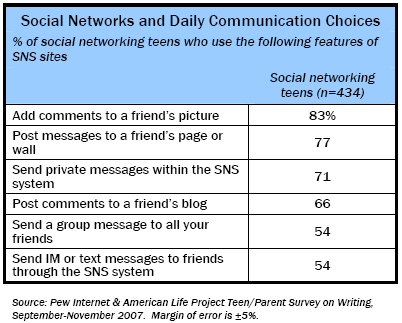
Among social networking teens, girls are more likely than boys to add comments to a friend’s picture (89% vs. 76% for boys), post messages to a friend’s page or wall (82% vs. 70%) and send a group message or bulletin (61% vs. 46%). Teens ages 15-17 are more likely than younger teens to post public messages on a friend’s page or wall (82% vs. 66%) and to send private messages within the social networking system (79% vs. 56%), although younger teens are more likely to send bulletin or group messages to all of their friends at once—63% of younger teens have done this, compared with 50% of older teens.
Among social networking teens, whites are more likely than blacks to use their social networking profile as a communication tool, whether to post messages to a friend’s wall (78% of whites do this, versus 63% of blacks) or to send private messages within the social networking system (75% v. 55%). Indeed, fifteen percent of black social networking teens do not do any of the six activities listed above, compared with just 4% of white teens. The sample size of social networking Hispanic teens (n=62) is too small to make meaningful inferences about the communication choices of this group.
Teens on opposite ends of the income scale are overall quite similar in how they use social networking sites to communicate with friends, if they use such sites in the first place. The one exception to this rule is the usage of social networking sites to send instant messages or text messages to friends. Fully 63% of teens from households earning under $50,000 per year do this, compared with half (49%) of teens from higher-income households (somewhat lower rates of cell phone ownership among lower-income teens may help explain this phenomenon).
In our focus groups, teens explained some of the allure of social networking websites and how use of them has changed and replaced other online practices.
It sounds stupid and everything but like once you like get into it it’s really like addicting – just like everything. Like you have your song and like you write like all this stuff about yourself and like all my friends basically have it. So like we always like read each other’s pages and like call each other and like kind of, and like you put like 300 pictures up so . . . people’s pictures and stuff and comments.
– 9/10th Grade Girl, Midwestern City.
[You go on MySpace] when all of your friends have gone to MySpace and they aren’t emailing anymore.
– 9/10th Grade Boy, Pacific Northwest City.
Social networking teens are avid communicators across the board.
While social networking sites are used intensively for communications between friends, these sites supplement rather than replace existing modes of communication. Social networking teens are more likely than non-social networking teens to participate in a wide range of daily communications activities, from in-person interactions with friends to talking on the telephone or sending IMs or text messages.
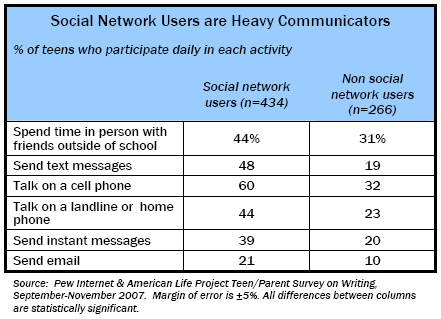
The shortcuts and casual conventions teens use in their daily communications frequently bleed into their school writing.
Despite their best intentions, teens in our survey do admit to using conventions from their electronic communications in their school writing. Half (50%) of teens say they sometimes use informal writing styles in the writing they perform in school, 38% have used shortcuts from instant messaging or email, and 25% have used emoticons in their school writing. Overall, nearly two-thirds of teens (64%) incorporate some informal styles from their text-based communications into their writing at school.
Since much of the writing teens do at school (such as writing in a journal, taking notes in class, or crafting creative fiction) is relatively informal in nature, it is not necessarily surprising to find teens adopting the conventions from texting, email or other online speech into their writing for school. With that said, certain groups of teens are more likely to utilize these conventions in their school writing than others.
While teen bloggers and social network users are prolific writers, they also have a tendency to use text shortcuts, emoticons and informal writing styles in their school writing. Similarly, teen cell phone owners are significantly more likely to use text shortcuts in school (42% do this) compared with non-cell phone owners (30%).
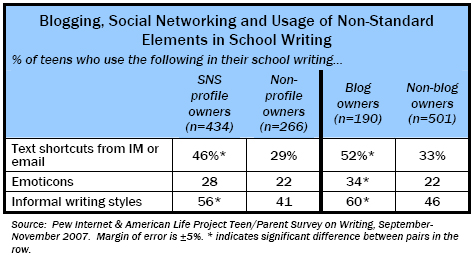
Teens who communicate regularly with their friends through a wide range of communications channels are more likely than less “communicative” teens to incorporate informal or technology-related elements into their school writing. The more types of personal daily communications teens engage in with friends, the more likely they are to incorporate these conventions into the writing they do at school.
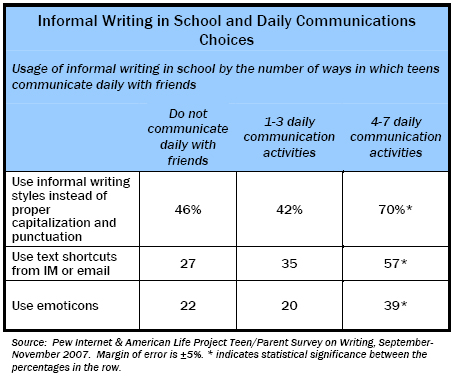
Usage of different communications methods outside of school is not the only factor correlated with usage of technology-based writing conventions in school—attitudinal factors play a role as well. In particular, teens who view their electronic communications with friends as “writing” are significantly more likely than teens who do not view these communications as writing to use informal writing styles (59% vs. 47%), text shortcuts (56% vs. 34%) and emoticons (39% vs. 19%) in a school environment.
Among demographic groups, girls are more likely than boys to use text shortcuts from IM or email (45% vs. 33%) and emoticons (35% vs. 17%). Black teens (48%) are more likely than whites (35%) to use text shortcuts in school, although there are no racial or ethnic differences with respect to usage of informal writing styles or emoticons. Finally, among children of college graduates, just over half (54%) use at least one of these elements in their writing for school; this is a significantly lower rate than for children of parents with some college education (67% of whom use at least one of these techniques), or for children of parents with no college experience (71%).
Teens in our focus groups acknowledged the movement of text-based slang into their school work, but also suggested that learning not to use the slang is a part of the maturation process. They also took this issue one step further by pointing out that not only had text message slang and informal language crept into their formal school work, but it had also infiltrated spoken language for some teens.
. . . [S]ince I was a sophomore in high school I have seen some changes. I saw some under classman in the hallway saying OMG where is my classroom or LOL and you know I was like, “OK, they are going to have to work through that.”
– 11/12th Grade Girl, Pacific Northwest City.
As you get older you develop and you learn that publicly it isn’t a good idea to use text message slang. It may influence people to think things about you. It will give the wrong impression of you.
– 11/12th Grade Girl, Pacific Northwest City.
I can speak very well, but there are also times that I have been laughing and actually said LOL. So it all depends on how much you text and who you are around at the time.
– 11/12th Grade Girl, Pacific Northwest City.
. . . [I]f people are going to think that the way we type on the internet is going to corrupt the way we write like for school, it’s just because those people don’t want to write normally and they’re not going to if they don’t want to.
– 9/11th Grade Girl, Southwestern City.




